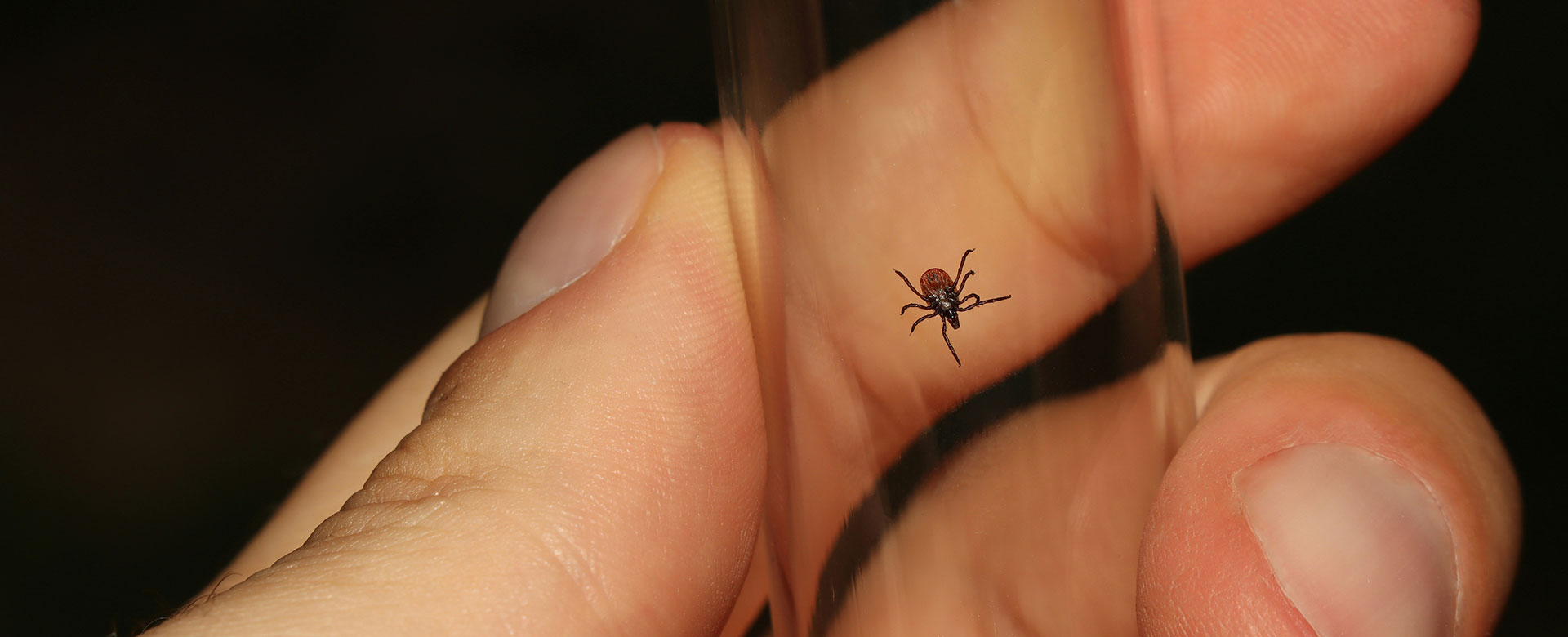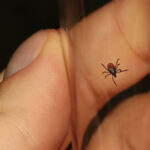What is it?
Lyme Disease is caused by a bacteria named Borrelia burgdorferi that is transmitted through the
bite of an infected deer tick (Ixodes scapularis). Lyme disease can affect dogs, humans and
horses. It is thought to be extremely rare in cats. Once an infected deer tick attaches to your
dog’s skin, it takes 24-48 hours for the tick to begin to transmit Borrelia.
If a tick has transmitted Borrelia to your dog, you will not see any sort of rash or external
indicator. In fact, it can take months before any symptoms of Lyme disease occur, if they occur
at all. Borrelia has adapted to be able to evade the immune system by hiding in the synovial
lining of joints within the connective tissue, often remaining dormant for prolonged periods of
time.
Tick populations have been expanding in Southern Ontario for years and we are now seeing
ticks year round. A recent study (Nabbout et al. 2023) showed that deer ticks infected with
Borrelia had greater survival over the winter, compared to deer ticks not infected with Borrelia,
which promotes the expansion of tick populations and thereby disease transmission.
Prevention
Medication
We recommend dogs be given an oral or topical isoxazoline medication, such as Bravecto,
Credelio, Nexgard, or Simparica. This medication ends up in your dog’s skin, and when a tick
attaches and begins to feed on your dog, the tick will ingest the medication, die and fall off in
less than 12 hours, before it has a chance to transmit Borrelia to your dog. Although
Isoxazolines are not tick repellents, they are very effective at preventing transmission of tick
borne disease. We recommend YEAR ROUND prevention.
If your dog has an underlying seizure disorder, it is not advised that they take these
medications, as they can reduce the seizure threshold, making seizure more likely to occur.
Although ticks are more commonly found in areas of tall grass or brush, pets and people are
coming in contact with ticks in the city and in neighborhood parks. Checking your pet for ticks
after returning home from a walk may not be enough, as they are challenging to spot. Many of
our clients did not know their pet had a tick before they were diagnosed with Lyme disease.
Vaccination
There is an effective yearly Lyme vaccine (Novibac by Merck) that can be given to your dog.
This is recommended for dogs exposed to high levels of ticks in their environment, for dogs who
cannot receive tick prevention medication due to underlying seizure disorders, or for
circumstances where it is challenging for pets to receive regular, timely doses of prevention
medications (low medication compliance rate).
How to remove a tick
Remove a tick by using fine-pointed tweezers to grasp the head of the tick (right where it enters
the skin) and gently but firmly apply traction to remove the tick. Make sure not to grasp or
squeeze the body of the tick, otherwise it might separate from the head.
Visit etick.ca for help with identifying species of ticks and tips on how to remove them.
I just removed a deer tick from my dog, now what?
If you know your pet was bitten by a deer tick, or if you removed a tick but were unsure which
species of tick it was, we recommend you have your dog tested for Lyme disease 6 weeks after
the known tick bite, using a 4DX Snap screening blood test. This test measures the dog’s
antibody levels against Borrelia bacteria. Elevated antibody levels take 6 weeks to rise following
infection, and can remain elevated for weeks to years. There is no reliable antigen test for
Borrelia, given that its biology is to hide in the lining of joint capsules to evade detection by the
immune system.
My dog tested positive for Lyme bacteria, now what?
Let’s go through some important facts
-
- Approximately 30% of dogs test positive for elevated antibody levels against Borrelia
(Lyme seropositive result on 4DX snap test) will show clinical signs of Lyme disease
- Approximately 30% of dogs test positive for elevated antibody levels against Borrelia
-
- That means approximately 70% of dogs will never show any clinical signs, many of
these dogs will go on to test negative in the future
- That means approximately 70% of dogs will never show any clinical signs, many of
-
- Of the dogs who do show clinical signs of Lyme disease, most take many weeks to
months following a tick bite to show signs. Most will show signs of joint pain and
inflammation. Less than 2% will show Lyme Nephritis – Borrelia bacteria infecting the
kidneys.
- Of the dogs who do show clinical signs of Lyme disease, most take many weeks to
-
- Dog do not show a bullseye rash associated with a Borrelia infected tick bite
-
- Dogs to not go on to have natural immunity against future Borrelia infections, meaning
they can become re-infected with Borrelia in the future and have repeated episodes of
Lyme disease
- Dogs to not go on to have natural immunity against future Borrelia infections, meaning
What are the signs of Lyme disease in the joints?
-
- Lameness, often in multiple limbs, shifting locations
-
- General stiffness, soreness, reluctance to move
-
- Lethargy
-
- Fever
If seen, please contact the clinic promptly, so we can perform a physical exam to determine if
the symptoms are in fact likely related to Lyme disease and begin treatment with antibiotics
How is Lyme Disease treated?
The most common antibiotic used is doxycycline for a 28 day long course. In some cases, anti-
inflammatory drugs or steroids are also warranted.
Treating an asymptomatic dog with doxycycline does not reduce the chance of becoming
symptomatic in the future, so treating all positive testing dogs is not recommended. It is
important not to overuse antibiotics, as it may lead to bacterial resistance.
What is Lyme Nephritis?
Rarely (< 2% of the time), a Lyme seropositive dog can develop Lyme Nephritis, which is a
severe form of kidney infection/inflammation that is often life threatening. It can be difficult to get much
warning when this will occur, as it develops quickly.
Experts advise screening all dogs who test Lyme seropositive with a blood work panel and urine
testing to screen for low grade Lyme Nephritis, so that early treatment can be initiated.
At the time of a Lyme seropositive diagnosis, a dog can show normal blood and urine results but
may still develop Lyme Nephritis in the future.
Symptoms of Lyme Nephritis
-
- Increased drinking, increased peeing
-
- Lethargy
-
- Reduced appetite
-
- Vomiting
Prognosis
A dog who develops joint inflammation caused by Lyme Disease can have a reasonably good
prognosis if symptoms are noted and treated promptly. Delays in treatment, or particularly
severe cases can result in permanent arthritic changes to the cartilage and bone in joints.
Lyme nephritis is not very well understood at this stage of our scientific knowledge. Many cases
result in very rapid onset, severe disease that is often fatal despite aggressive treatment, but
some cases have been successfully treated.
Asymptomatic dogs may end up naturally clearing the Borrelia infection and end up testing
negative in the future.
Dr. Melanie Gagnon, BSc, DVM
Southgate Animal Hospital
References:
ACVIM Consensus Statement on Lyme Borreliosis in Dogs and Cats (updated in 2018)
https://onlinelibrary.wiley.com/doi/full/10.1111/jvim.15085
Nabbout, A.E. (2023) Female ticks (Ixodes scapularis) infected with Borrelia burgdorferi have
increased overwintering survival, with implications for tick population growth. Insect Sci.
30(6):1798-1809 https://pubmed.ncbi.nlm.nih.gov/37147777/




